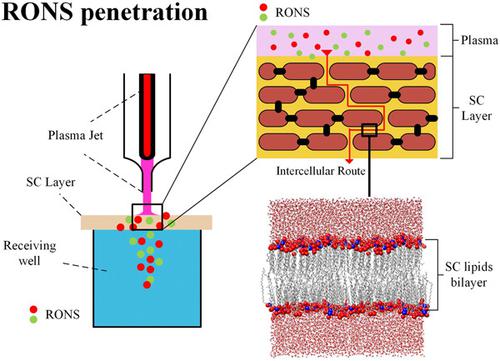当前位置:
X-MOL 学术
›
Plasma Processes Polym.
›
论文详情
Our official English website, www.x-mol.net, welcomes your feedback! (Note: you will need to create a separate account there.)
The penetration of reactive oxygen and nitrogen species across the stratum corneum
Plasma Processes and Polymers ( IF 3.5 ) Pub Date : 2020-06-02 , DOI: 10.1002/ppap.202000005 Jiangwei Duan 1, 2, 3 , Mingyu Ma 1 , Maksudbek Yusupov 3 , Rodrigo M. Cordeiro 4 , Xinpei Lu 1, 2 , Annemie Bogaerts 3
Plasma Processes and Polymers ( IF 3.5 ) Pub Date : 2020-06-02 , DOI: 10.1002/ppap.202000005 Jiangwei Duan 1, 2, 3 , Mingyu Ma 1 , Maksudbek Yusupov 3 , Rodrigo M. Cordeiro 4 , Xinpei Lu 1, 2 , Annemie Bogaerts 3
Affiliation

|
The penetration of reactive oxygen and nitrogen species (RONS) across the stratum corneum (SC) is a necessary and crucial process in many skin‐related plasma medical applications. To gain more insights into this penetration behavior, we combined experimental measurements of the permeability of dry and moist SC layers with computer simulations of model lipid membranes. We measured the permeation of relatively stable molecules, which are typically generated by plasma, namely H2O2, NO3−, and NO2−. Furthermore, we calculated the permeation free energy profiles of the major plasma‐generated RONS and their derivatives (i.e., H2O2, OH, HO2, O2, O3, NO, NO2, N2O4, HNO2, HNO3, NO2−, and NO3−) across native and oxidized SC lipid bilayers, to understand the mechanisms of RONS permeation across the SC. Our results indicate that hydrophobic RONS (i.e., NO, NO2, O2, O3, and N2O4) can translocate more easily across the SC lipid bilayer than hydrophilic RONS (i.e., H2O2, OH, HO2, HNO2, and HNO3) and ions (i.e., NO2− and NO3−) that experience much higher permeation barriers. The permeability of RONS through the SC skin lipids is enhanced when the skin is moist and the lipids are oxidized. These findings may help to understand the underlying mechanisms of plasma interaction with a biomaterial and to optimize the environmental parameters in practice in plasma medical applications.
中文翻译:

活性氧和氮物质穿过角质层的渗透
在许多与皮肤有关的血浆医学应用中,活性氧和氮物质(RONS)穿过角质层(SC)的渗透是必不可少且至关重要的过程。为了获得对这种渗透行为的更多了解,我们将干燥和湿润SC层渗透性的实验测量结果与模型脂质膜的计算机模拟相结合。我们测量相对稳定的分子,其通常通过等离子体产生的,渗透即ħ 2 ö 2,NO 3 -和NO 2 - 。此外,我们计算了主要血浆生成的RONS及其衍生物(即H 2 O 2,OH,HO 2,O- 2,O- 3,NO,NO 2,N 2 ö 4,HNO 2,HNO 3,NO 2 -和NO 3 - )跨越本地和氧化SC脂质双层,了解RONS机制跨越SC渗透。我们的结果表明,疏水性RONS(即NO,NO 2,O 2,O 3和N 2 O 4)比亲水性RONS(即H 2 O 2,OH,HO 2)更容易跨SC脂质双层迁移。,HNO 2和HNO3)和离子(即,NO 2 -和NO 3 - ),其经历高得多的透过的障碍。当皮肤湿润并且脂质被氧化时,RONS通过SC皮肤脂质的渗透性增强。这些发现可能有助于了解等离子体与生物材料相互作用的潜在机制,并在等离子体医学应用中实践中优化环境参数。
更新日期:2020-06-02
中文翻译:

活性氧和氮物质穿过角质层的渗透
在许多与皮肤有关的血浆医学应用中,活性氧和氮物质(RONS)穿过角质层(SC)的渗透是必不可少且至关重要的过程。为了获得对这种渗透行为的更多了解,我们将干燥和湿润SC层渗透性的实验测量结果与模型脂质膜的计算机模拟相结合。我们测量相对稳定的分子,其通常通过等离子体产生的,渗透即ħ 2 ö 2,NO 3 -和NO 2 - 。此外,我们计算了主要血浆生成的RONS及其衍生物(即H 2 O 2,OH,HO 2,O- 2,O- 3,NO,NO 2,N 2 ö 4,HNO 2,HNO 3,NO 2 -和NO 3 - )跨越本地和氧化SC脂质双层,了解RONS机制跨越SC渗透。我们的结果表明,疏水性RONS(即NO,NO 2,O 2,O 3和N 2 O 4)比亲水性RONS(即H 2 O 2,OH,HO 2)更容易跨SC脂质双层迁移。,HNO 2和HNO3)和离子(即,NO 2 -和NO 3 - ),其经历高得多的透过的障碍。当皮肤湿润并且脂质被氧化时,RONS通过SC皮肤脂质的渗透性增强。这些发现可能有助于了解等离子体与生物材料相互作用的潜在机制,并在等离子体医学应用中实践中优化环境参数。


























 京公网安备 11010802027423号
京公网安备 11010802027423号